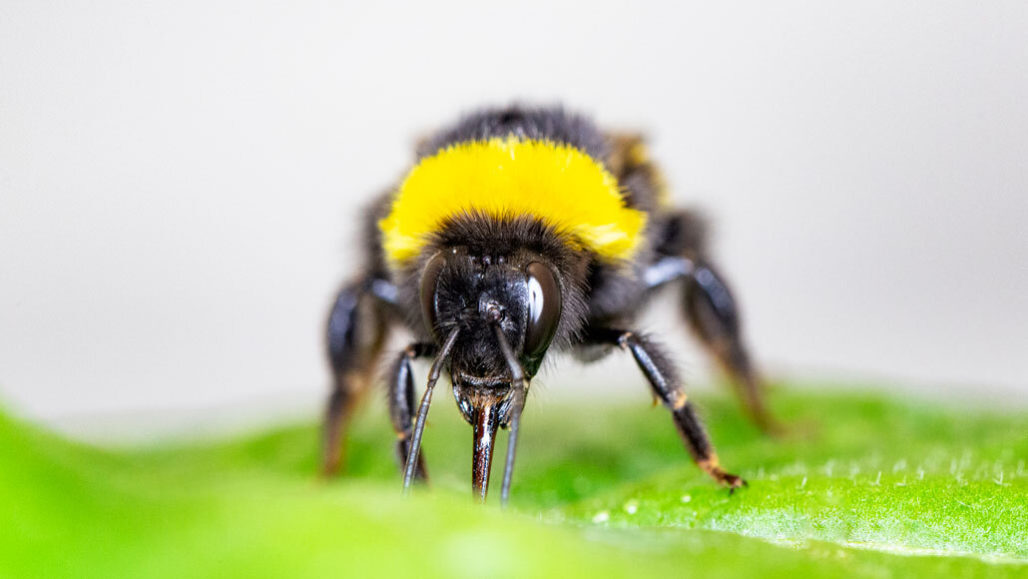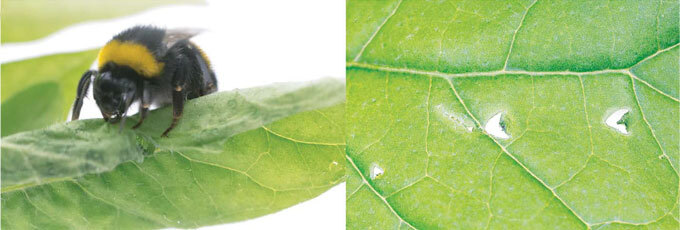Bumblebees may bite leaves to spur plant blooming
In a pollen shortage, bees can make tomatoes bloom early by biting foliage

A bumblebee sinks its mouthparts into a plant leaf to make a small hole. Little cuts like this seem to jolt plants into starting to flower early. That’s can help a bee deprived of pollen.
Hannier Pulido, C. De Moraes, Mescher Laboratories
By Susan Milius
Here’s a tip for bumblebees to get a slowpoke plant to bloom early. Just bite its leaves.
At least three species of bumblebees use their mouths to snip little confetti bits out of plant foliage. This foliage biting gets more common when there’s a pollen shortage, says Consuelo De Moraes. She’s a chemical ecologist and entomologist who works at ETH Zurich in Switzerland. Her team reported its findings in the May 22 Science.
De Moraes and her colleagues set up experiments with mustard and tomato plants. Plants nibbled by Bombus terrestris bees bloomed days or weeks earlier than unbitten plants. For these bumblebees, accelerating bloom times could be a lifesaver. When trying to start colonies in early spring, the bees rely on flower pollen as a protein source to feed their young.
Foteini Paschalidou is an ecologist now at France’s National Institute for Agricultural Research in Versailles-Grignon. She was the first team member to call attention to the behavior. She was working indoors on a different project with caged B. terrestris bees. At first, De Moraes worried. “Is it something wrong with them?”
The bees’ supplier and some farmers who used them to pollinate crops assured the researchers that nipping happens elsewhere. The team, though, hasn’t found any accounts in the scientific literature.
Biting bumblebees
To test a link between leaf biting and pollen shortages, the researchers did a caged-bee test. First, they deprived the insects of pollen for three days. Then the researchers trapped the bumblebees with nonblooming plants. These bees were more likely to poke holes in foliage than a bee group buzzing among plants with plentiful flowers. When researchers swapped the bees’ situations, the insects now trapped without blooms started nibbling leaves.
The team also did tests on the roof of the lab building. There the bees were free to seek flowers in rooftop planters and elsewhere. These tests, too, linked pollen shortage and increased leaf biting.

The notion that bee damage to a leaf could jump-start flowering originally struck Mark Mescher as a long shot. Mescher is a coauthor, also at ETH Zurich. Yet in lab tests, tomato plants punctured five to 10 times by pollen-deprived bees bloomed 30 days earlier on average than did undamaged plants. But the speed-up time varied by plant species. For instance, bee-nipped black mustard (Brassica nigra) bloomed only about 16 days early.
This acceleration in bee-pestered plants is not entirely a surprise. Other types of stress also have triggered early blooming, he points out. Those stressors include drought, skimpy nutrients and assault by leaf-eating insect pests. But how bee bites might tap into the internal clock that triggers a plant to switch from leafing to flowering remains a big question.
Scientists waiting with forceps and a razor on a lab rooftop tried to mimic bee activity in real time, bite by bite, on comparison plants. But the scientists got only a modest acceleration in the black mustard, and no real change in the tomatoes. So there might be something special in a bee bite.
In a happy accident, the outdoor trials attracted visits from two other Bombus species. Those bees checked out the plants on offer and also nicked holes in leaves. That confirms that leaf nibbling is not just some quirk of a commercial line of bees. However, two long-time bumblebee watchers — Dave Goulson at the University of Sussex in England and Lynn Adler at the University of Massachusetts Amherst — say they’ve never noticed it.
Goulson says he’s fascinated by the idea. B. terrestris commonly cuts holes in plant parts, but in a slightly different context. Sometimes these and other bumblebees don’t grope for nectar through the natural openings of flowers. Instead, they just bite little holes through the outer wall of a flower for a sip. “I can imagine that hungry bees unable to find flowers might try biting leaves in desperation,” he says. Flower biting might thus have evolved into leaf biting. However, as Mescher points out, it could have happened the opposite way, too.
With those intriguing ideas buzzing around, clearly now is a great time to go watch bees.







